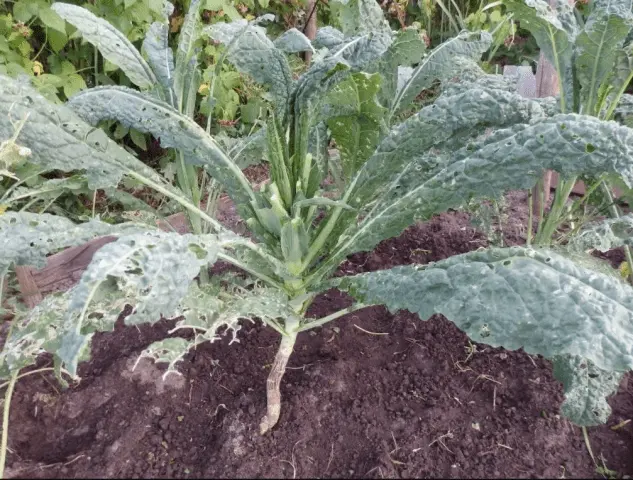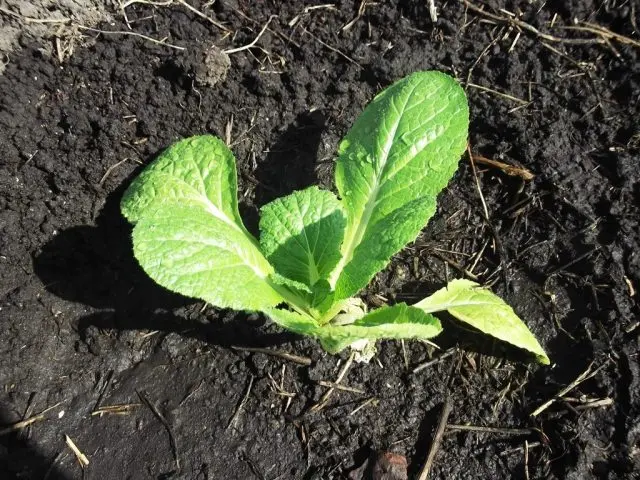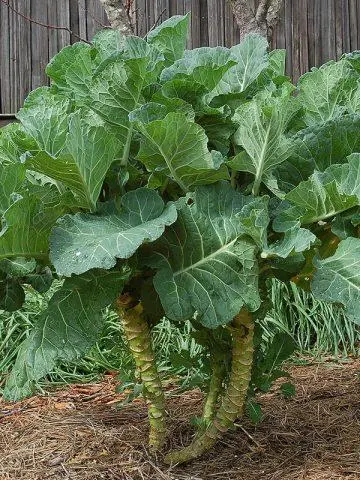Contents
Kale is a special kind that is used only as animal feed. The plant develops within two years. It has an unusual shape – fleshy stems, long and large leaves of dark green color. Cabbage does not produce heads of cabbage as such. The culture is unpretentious, grows normally even with frosts, but needs watering.
What is fodder cabbage
Fodder cabbage belongs to the same cruciferous family as other varieties (white cabbage, broccoli, Brussels sprouts and others). The culture is unpretentious, grows well in almost all regions of Our Country. Grown for livestock feed, not used for food.
It has fairly strong stems and long leaves. Both parts are used for feeding. Withstands negative temperatures, even short-term drops to -6 degrees. In care, the culture is very simple, copes with severe drought.
Description and photo of fodder cabbage
Fodder cabbage refers to biennial plants. Reaches a height of 1 m or a little more. In the first season, the stems acquire a cylindrical shape, then they become like a spindle. Further, branches are formed on them.
The foliage of fodder cabbage reaches 50 cm in length and 40 cm in width. A not too pronounced wax coating is noticeable on the surface. Foliage color ranges from green to purple. The shape is lanceolate, ovoid, sometimes in the form of a lyre. Petioles are also quite long – 15-40 cm. In the second year, new shoots are formed. It is they who give small flowers, reaching 4-5 cm in diameter.
The stems grow up to 1,5-2 m in length, which is very different from the white-headed and other varieties. They are 3-5 cm thick, rarely reaching 10 cm. Just like the leaves, they are covered with a wax coating.

Kale is a valuable agricultural crop
It contains dry matter with a mass fraction of up to 15%. The composition includes vitamins C, group B, carotene, protein, minerals and fiber. It has good milk-producing properties. They are mainly used to feed cows.
Varieties of fodder cabbage
There are not many varieties of fodder cabbage. The most commonly grown varieties are:
- Brain Green Vologda.
- Thousand-headed.
- Podmoskovnaya.
- Brain Green Siverskaya.
- Polar 227.
- Milestone.
Recently there are also Dutch hybrid varieties. These are forage cabbage Reflex and Redbor. They were approved for cultivation in 2000. They give palm-shaped plants. A characteristic detail – the foliage is painted in burgundy shades.
In terms of productivity, the varieties of fodder cabbage Polyarnaya 227 and Podmoskovnaya are of the greatest value. They give very large leaves, and it is their share that accounts for up to 3/4 of the crop. At the same time, in other representatives, the ratio is approximately the same – half falls on the leaves and the second part – on the stems.
Technology of growing fodder cabbage
Since cabbage is unpretentious, it can be grown in a seedless way. In farming practice, they most often do this – they sow seeds in the ground, occasionally water them, and apply top dressing. This is a fairly easy method, but germination is low, some of the seeds may be lost.
To reduce losses by 60%, it is recommended to use the seedling method. It is more labor intensive, but the germination rate increases. This option is suitable for relatively small areas where many seedlings are not needed. The main growing steps for each method are described in the following sections.
seedless way
You can start sowing seeds of fodder cabbage in open ground already in early April, and in the south – from the end of March. Sprouts well withstand temperatures around zero and frosts down to -6 degrees. Therefore, you should not be afraid that they will not germinate.
When landing, they act like this:
- Clean up and dig up the area.
- Level the surface.
- Furrows are marked at a distance of 70 cm.
- Seeds are sown at 2-3 cm.
The consumption rate is from 15 to 40 kg per hectare of land. Since the seeds of fodder cabbage are very small, they must first be mixed with superphosphate, sifted through a small sieve in a ratio of 1:10. It will not only provide nutrients, but also allow the seeds not to go too deep.

Seedlings of fodder cabbage can be transplanted into open ground in early April
After a few days, shoots appear, then 3-4 true leaves are formed, then the crops are thinned out, leaving 20-30 cm between adjacent plantings. But if the variety produces very large leaves, the interval should be 40 cm. Only the strongest seedlings should be left.
Through seedlings
To grow seedlings of fodder cabbage, it is necessary to sow the seeds 40-45 days before transplanting into the ground. Usually it is planned for the beginning of April, so work can begin as early as the end of February. If the lighting is not enough, it is allowed to sow in early March.
Before planting, the seeds are also mixed with superphosphate and sown in common boxes. Moisten from a spray bottle, cover with a film, periodically remove for ventilation. Water regularly to keep the soil consistently moist.
After the emergence of shoots of fodder cabbage, the film is completely removed, then thinned out. As soon as 4-5 leaves are formed, the seedlings begin to harden at a temperature of 10-12 degrees. If the room is too warm, the sprouts will begin to stretch.
The transplant is planned for a cloudy day, when the temperature outside is 5-10 degrees Celsius. Landing patterns may vary. 60-70 cm are always left between rows. And the seedlings themselves are placed at a distance of 20-25 to 50-60 cm. If the plants are too large, they can be planted in a checkerboard pattern.
Care
Caring for kale is very easy. But it is important to remember that the plant is moisture-loving, so watering should be plentiful and regular. It is especially important to do this in the second half of summer and early autumn, when cabbage is actively gaining green mass. Water is given every 5-7 days, and in the heat – twice as often. It is best to take settled liquid at room temperature.
On the other hand, it is also impossible to allow waterlogging, since plants can suffer from excess water. Therefore, it is necessary to observe the watering rate, focus on the weather forecast. To keep the soil moist longer, lay out a layer of mulch (hay, sawdust, straw).
Top dressing is enough to make twice a season – in May and at the end of June. To do this, use the following mixture (per square meter):
- superphosphate 30 g;
- nitrophoska 30 g;
- ammonium nitrate 15 g.
Along with this, you can use ready-made formulations, for example, Agricola. It is also allowed to use liquid organics – litter 1:20 or mullein 1:10.

Forage cabbage does not need special care
Pests and diseases
The culture is unpretentious and quite rarely affected by diseases or pests. But sometimes it can suffer due to improper watering. As a rule, rot and other infections develop for this reason. Therefore, water should be given in moderation, and if the summer is rainy, refrain from watering.
Among the diseases, the following infections are of particular danger:
- blackleg;
- spotting on leaves and pods;
- hernia;
- gray rot.
You need to fight them with the help of fungicides – “Maxim”, “Tattu”, “Ordan”, “Bordeaux liquid” and others.
Pests include the same insects that are dangerous for other varieties of cabbage:
- Cruciferous fleas – you can find out about their appearance on a fodder crop by small holes on the leaves. To combat, a mixture of ash and ash is sprayed (in equal amounts).
- Cabbage moth – butterflies of a grayish hue, have a long body. Quite dangerous for fodder cabbage, you need to fight with the biological preparation Lepidocide.
- Rape beetle – black beetles of small size (within 1 cm). They eat buds and seeds. To save fodder cabbage, they are treated with drugs such as Etaphos and Andometrin.
- Cabbage fly – resembles the usual one, but has a brown color. For the destruction and protection of fodder cabbage, they are treated with insecticides. The most effective drugs are Karbofos and Iskra.
Collection and storage
Harvesting fodder cabbage starts much later than in the case of the usual white varieties. This is precisely the main goal of cultivation – to get as many leaves and stems as possible. Determining the collection time is quite simple – as soon as the foliage begins to turn yellow (from the bottom of the bush), the moment is right.
As a rule, the collection time falls on the second half of October. In the southern regions of Our Country, they begin to dig even in the first half – mid-November. If autumn is too warm, even at the end of the month. You should not worry about the onset of frosts – fodder cabbage is harvested after them, when all crops have been harvested for a long time.

Harvesting should be done no earlier than the end of October.
It can be stored both fresh and in the form of silage. In the first case, they are kept in the basement at temperatures up to +8 with constant ventilation. Humidity should be moderate, then the cabbage will lie until February.
Plants can also be ensiled. They operate like this:
- First, the harvested crop is crushed.
- Then mixed with other ingredients.
- They put it in a hole and leave it to ferment.
Conclusion
Fodder cabbage is generally unpretentious, so even an inexperienced summer resident can grow it if desired. This is a valuable fodder crop, not inferior to oats. For long-term storage, it is recommended to lay in well-ventilated basements or ensilage.









